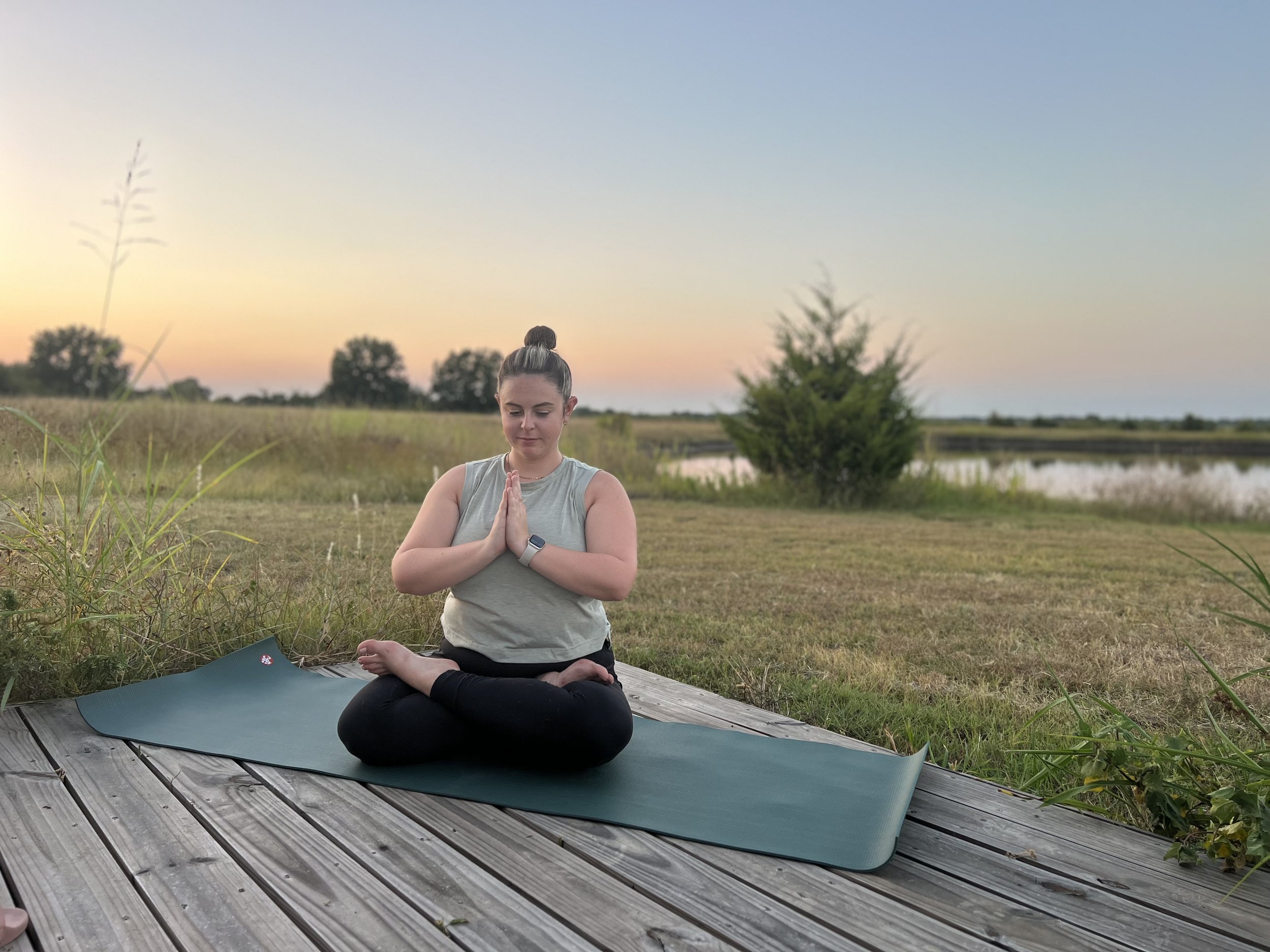Defining Meditation & mindfulness
Meditation and mindfulness have become buzzwords that we see all over the media lately. And, even though we see the words often, we may not know exactly what those words mean or how they differ. More importantly, there is not always a clear connection between meditation and mindfulness as it relates to mental health. Mindfulness and meditation can be a useful tool for self-awareness and self-soothing.
Aubrey Richardson LPC (owner & therapist at Sage Holistic Counseling) meditating in a prayer pose to represent the differences between being mindful and having a formal meditation practice
Mindfulness
Mindfulness, or being mindful, is the ability to recognize your experience as it is happening at the moment. We can practice mindfulness at any time, anywhere. For example, we can drink a cup of coffee mindfully, take a mindful walk through nature, or even wash the dishes mindfully. When we drink a cup of coffee mindfully, we use all of our senses to notice the warm mug in our hands, feel the liquid touch our lips, and notice the acidic taste in our mouths.
The opposite of practicing mindfulness is being in autopilot mode. We fall into autopilot mode when we stop paying attention like when we suddenly find ourselves in our driveways but don’t remember the drive home from work. We didn’t fall asleep or else we would have crashed the car. We just weren’t paying attention or being mindful.
Core Components of Mindfulness:
Noticing and Describing Observation using our five senses is a key feature of mindfulness. Observation includes focusing on noticing and sensing our experience in a more direct way through our emotions, thoughts, and physical sensations. As humans, our tendency is to use our thinking brains and to “think about” our experiences instead of “feel through” them. Mindfulness encourages us to step out of our analytical mode to shift to noticing our full experience with kindness and curiosity.
Non-judgement When we describe our thoughts, feelings, and physical sensations, mindfulness encourages us to practice non-judgement. Instead of labeling sensations as “good”, “bad”,“right” or “wrong” try to accept all parts of your experience. Part of the reason we experience prolonged emotional distress is that we attempt to deny, minimize, and control unpleasant thoughts, feelings, and sensations. Instead, try to use neutral and more descriptive language like “heavy” or “tense” to describe difficult feelings and practice using realistic statements like “I am noticing a tightness in my chest. I am experiencing some anxiety right now and that’s okay”.
Participating Fully
When we practice noticing, describing, and non-judgement we may begin to notice the more unpleasant parts of our experiences. This is okay and normal. It is never comfortable or pleasant to have negative feelings, thoughts, or sensations; however, these are all part of the full range of emotions available during the human experience. It is not realistic to only experience positive feelings and thoughts all day every day. Instead, practice participating fully by acknowledging both the pleasant and unpleasant, giving each their appropriate time and space, then letting it go.
Mindfulness versus Meditation
Typically, mindfulness and meditation are terms that are used interchangeably. However, this is not accurate. If mindfulness is the ability to recognize our experiences as they happen, meditation is the formal practice of mindfulness. Meditation is only one way to practice mindfulness in our daily lives, and there are many types of formal meditation practices. Meditation has roots in the Buddhist tradition and has spread across the globe, gaining popularity inside and outside of therapy spaces.
Types of Meditation Practices
Progressive muscle relaxation (PMR) - From the top of your head to the tip of your toes, each muscle group is first tensed and then released to bring relaxation into the body.
Body scan - Each part of the body is given mental attention, offering opportunities to notice any tension, then send breath to those tense areas to create more space and relieve tension. *This may not be comfortable and/or appropriate for individuals who have experienced trauma to the body without the assistance of a therapist.
Guided visualization - With your eyes closed, you visualize a comfortable, safe space like a forest or a beach.
Concentration meditations - This meditation focuses on the breath and uses a counting tool to cultivate concentration.
Loving-kindness (metta) meditation - Builds compassion, empathy, and forgiveness for yourself and the world. It asks you to send loving-kindness first to yourself, then to a loved one, then to a difficult person in your life, and finally to the entire world.
Want to meditate with ME? Check out my YouTube channel below: https://www.youtube.com/@SageHolisticCounseling
